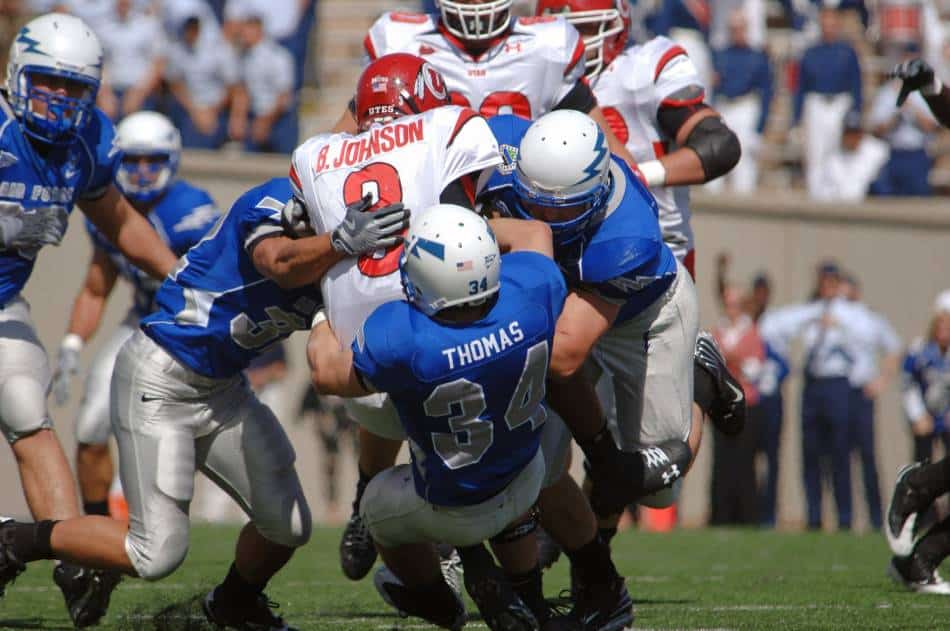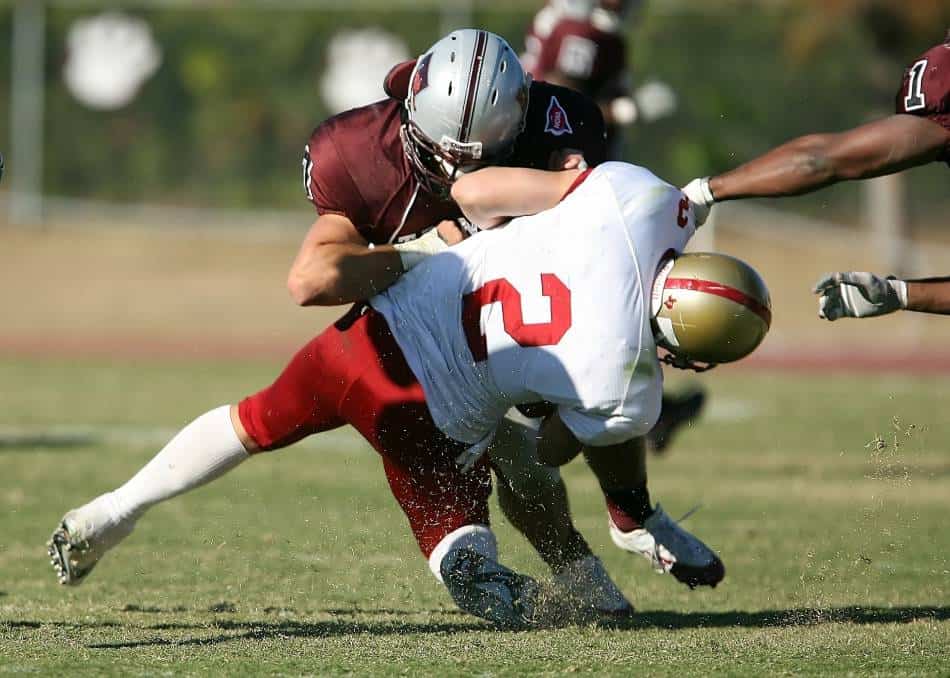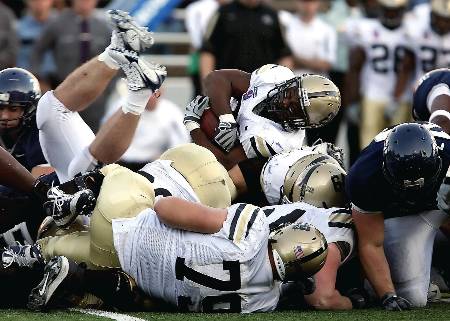
The lingo used in football contains a long list of homonyms, making it rather difficult for anyone trying to learn the game for the first time. We’re going to clear up any confusion around one of those homonyms – the term ‘safety.’
So, what is a safety in football?
In football, a safety is a scoring play that grants the defense two points. It also refers to a position group on the defensive side of the ball that consists of the free safety and strong safety. Safeties are also referred to as defensive backs and play a heavy role in pass-defense.
When it comes to scoring plays, safeties aren’t very common in the game of football. As for the safety position, it is one of the more important positions on defense, playing a role in both stopping the run and pass.
To ensure you fully understand the difference between the two, we’re going to dive into much further detail below.
Scoring a Safety in Football
The NFL rule book is changing every year as new precautions are taken into account. It’s one of the ways the NFL plans on keeping things interesting for the teams and exciting for the fans.
The safety hasn’t changed much throughout history, but the NFL added a one-point safety to the equation due to some rule changes in 2015.
This adds some extra confusion to what a safety is in football but we’re going to break down the differences for you!
How Do You Score a Two-Point Safety in Football?

We’ll explain the two-point safety first because it’s the traditional and more-common way of scoring a safety. There are several ways a defense can score a safety, which include:
- Tackling an offensive player in their end zone
- Forcing the offense to commit a foul in their end zone
- Forcing the offense to take a knee in their end zone
- Forcing the offense out of bounds in their end zone
In addition to the two points, the defense will also receive the ball after scoring a safety. After the play is over, the team that was just on offense has to complete a free-kick. This is different from a normal kickoff, but it does give the team that was just on defense the ball.
The free-kick is taken from the 20-yard line and has to be a punt, dropkick, or place kick. The returning team (the team that scored the safety) will then get to return the kick or take a knee to start their offensive drive.
A safety is different than when the defense intercepts or recovers the ball and walks in the end zone — that would be a touchdown for the defense. Safeties can only occur when the offense has the ball in their end zone and the play is called dead.
How Do You Score a One-Point Safety in Football?
Like we mentioned earlier, the one-point safety is a newer rule in the NFL. It’s been possible to earn a one-point safety since the beginning of the NFL, but there were a plethora of rules standing in its way.
It wasn’t until the 2015 extra point rule change that made it more possible.
The one-point safety is different from the two-point safety because it benefits the offense instead of the defense. It occurs when the defense gains possession of the ball during an extra point or two-point conversion attempt. The defense then gets tackled by the offense in their end zone.
Since the roles of the offense and defense are switched when the defense gains possession, the offense would be awarded the safety for tackling the defense in the end zone.
Hence, the offense receiving one point. Once the offense gets their point, they still have to kick the ball off on the following play.
How Often Do Safeties Happen in the NFL?

If you were hoping to see safeties a lot in football, think again because they’re one of the least common ways a team can score. Their rare occurrence makes them extremely exciting to watch, despite them being worth the least amount of points.
Viewed as game-changers, two-point safeties occur about every 14 games in the NFL — according to the NYTimes.
That means there’s about one safety every week of NFL action, which isn’t that often when you consider how many times teams score touchdowns and field goals each week.
On the other hand, one-point safeties are even rarer than two-point safeties. They’re so rare that the NFL has never seen one happen in nearly 100 years of existence.
Even Division I college football, which consists of an enormous amount of weekly games, has only ever seen two one-point safeties.
The first one occurred in 2004 when the Texas Longhorns and Texas A&M Aggies went head-to-head. The Longhorns were attempting an extra point, but the Aggies blocked the kick and recovered the ball.
Unfortunately, the Aggies player fumbled the ball back into their end zone and a teammate fell on it. This awarded the Longhorns with one point.
The second occurrence came during the 2013 Fiesta Bowl, which pinned the Oregon Ducks up against the Kansas State Wildcats. The Ducks had just scored a touchdown and were lining up for the extra point. Again, the kick was blocked and the Wildcats recovered it.
The Kansas State ball carrier ended up running back into his end zone and tossed the ball to a teammate who was also in the end zone to keep the play alive.
The teammate didn’t catch the football cleanly and got tackled in the end zone, which led to Oregon being awarded a one-point safety.
How Do Offenses Avoid Safeties?
When the offense has their backs up against a wall and is near their goal line, they will have several different options to hopefully get out of the situation.
The first option is giving up on the drive and punting the ball away. Most teams will only use this option when it’s fourth down, but it can be used before that if needed (it’s just extremely rare).
The second option is using low-risk plays to try and inch forward. At the very least, you’ll want to give yourself enough room to punt the ball comfortably.
Most teams will opt to run the ball in these situations since the quarterback will have to back up into the end zone to throw the ball. The moment the quarterback enters that end zone, he is at risk of being tackled for a safety.
At the end of the day, avoiding a safety starts with staying out of your end zone and that requires you to move the ball efficiently down the field. Smart and effective play-calling will solve this, as well as players that can execute on offense.
How Do You Play Safety in Football?

Now that we’ve taken a closer look at scoring a safety in football, it’s time to look at the other half of the equation — playing the safety position in football.
While the safety score and safety position have nothing in common, the safety position can score a safety — the same way any other defensive player would score a safety.
The safety (S) position is a position group that consists of two different defensive players – the free safety (FS) and strong safety (SS). They are a part of a larger position group called defensive backs (DB).
Both the free safety and strong safety play side-by-side most of the time, largely in control of pass coverage deep down the field. They’re often known as the last line of defense and if they screw up their team usually gives up a big play.
We’re going to take a closer look at each safety position individually since they each have different roles. Let’s dive in!
What Is a Strong Safety?
The strong safety is the more versatile of the two safeties, being asked to stop both the run and passing game. At times, they’ll line up in the back of the defense with the free safety, but you’ll often see the strong safety line up as a linebacker as well.
The term ‘strong’ safety isn’t random; it refers to the fact the player will line up on the strong side of the field — the side where the tight end is. This is where you’ll often see the strong safety on the line of scrimmage, right where the tight end lines up.
When they line up here, it gives them two options — cover the running back or cover the tight end. Because strong safeties are usually big and fast, they have the ability to move around the field and go where they’re needed.
In theory, the strong safety will have more opportunities to score a safety or sack because they’ll get more opportunities when lining up as a linebacker. They are often known for their big hits and big plays down the field.
In zone coverage, the strong safety is generally given the specific assignment to cover the hash mark when playing a Cover 2 Zone and is asked to cover the hash-to-sideline when in a Tampa 2 Zone.
What Is a Free Safety?

On the other hand, the free safety is asked to do a majority of their work in pass coverage. They are often the true last line of defense because they will rarely be found at the line of scrimmage.
This is why a majority of the free safeties are the ones who get interceptions.
At times, the free safety might be tasked to stop the run. This will mainly occur when the defense knows it’s a run play and the free safety is unblocked by the offense. This gives the free safety an open lane to the running back or quarterback if he’s fast enough.
In terms of their build, free safeties are generally more lean and fast. Being the last line of defense, you need to be able to cover anyone on the opposing team in case they break free.
This makes it more difficult for free safeties to succeed because offensive players in the league keep getting bigger and faster.
The free safety will often be asked to sit back, survey what’s happening on the field, and decide where he needs to be – which is generally where the action is. Being the one that’s often unblocked, the free safety gets to pick his battles carefully and acts as help for the rest of the defense.
In addition to that, the free safety will typically play zone even when the rest of the defense is playing man-to-man defense.
In certain special defensive packages, the free safety will be tasked with playing man-to-man, where he will likely be seen at the line of scrimmage similar to a cornerback.
How Many Safeties Are On a Football Team?
Every NFL team has a total of 53 permanent roster spots. They have more spots available during the preseason, but once the regular season starts it’s 53 players — plus 10 on the practice squad.
Of those 53 roster spots, a team generally elects to have anywhere from 2-5 safeties on their roster at any one point in time. Two of those roster spots are the starting strong safety and starting free safety, but most teams don’t keep too many safeties beyond that.
If a team elects to keep extra defensive backs, they’ll often keep versatile cornerbacks over safeties. At the end of the day, it mostly depends on the type of defensive scheme the coach wants to run and that might change week-to-week.
What Makes a Good Safety in Football?

There are several traits that scouts are looking for in safeties today, whether you’re a strong safety or free safety. One of the most significant concepts you need to master is your different coverages.
If you can’t understand and break down the different coverages (Cover 0, Cover 1, Cover 2, Cover 3, and Cover 4) in real-time, you’ll never survive as a safety. Your teammates and coaches need to trust that you’ll be where you need to be when you need to be there.
Scouts are also interested in your instincts, reaction time, and ability to think on the fly. You need to have a good eye for what’s happening on the field and have a high football IQ. As far as physical traits, you’ll generally be asked to have speed, strength, and size. If you can’t tackle, you can’t defend.
Overall, scouts today want a safety that’s willing to be versatile when on the field. You’ll receive more playing time and attention if you can double as both a strong and free safety — and maybe even triple as a cornerback when needed.
Best NFL Safeties of All-Time
There have been so many great safeties to play the game of football, it’s difficult to pinpoint any kind of list. I do, however, think there are a few safeties that stand out as some of the players that helped make the position what it is today.
Let’s take a look at five of the most popular safeties (in no particular order) the NFL has ever seen, as well as some of their stats provided by ESPN and Pro Football HOF:
- Troy Polamalu – 158 games played, 771 tackles, 12 sacks, 14 forced fumbles, 7 fumble recoveries, 32 interceptions, 3 touchdowns, 110 passes defensed, 47 stuffs and one blocked kick
- Ed Reed – 174 games, 644 tackles, 6 sacks, 11 forced fumbles, 10 fumble recoveries, 64 interceptions, 7 touchdowns, 140 passes defensed, 32 stuffs and 4 blocked kicks
- Ronnie Lott – 192 games played, 63 interceptions, 5 touchdowns, 17 fumble recoveries and 8.5 sacks
- Paul Krause – 226 games played, 81 interceptions, 6 touchdowns, 19 fumble recoveries 1 passing touchdown
- Larry Wilson – 169 games played, 52 interceptions, 7 touchdowns, 14 fumble recoveries and one safety
When you look back at these players’ careers, Troy Polamalu was always at the right place at the right time. Ed Reed was a dual-threat ready to make the big play or big hit.
Ronnie Lott was the Ed Reed of the 80s and 90s with an intimidating playing style. Paul Krause was an elite ball-hawk and Larry Wilson basically invented the safety blitz.
How Much Do Safeties Make in the NFL?

Taking a look at the current salaries around the NFL, safeties that are good at what they do have the potential to make a pretty penny. The top-eleven highest-earning safeties in the NFL are paid above $10 million per year, with the highest being Eddie Jackson at $14.6 million per year.
For comparison, that’s nearly $900,000 per game for Eddie Jackson, which is incredible. At the same time, it’s nothing compared to some of the highest-paid players in other positions.
The only players that generally get paid less than safeties are tight ends, fullbacks, kickers, punters, and long-snappers.
After the 11 highest-paid safeties in the NFL, salaries start to drop off. Players 12-28 make between $5-$10 million per year, while players 29-57 make between $2-$5 million per year.
Summarizing Everything We’ve Learned
I know we just threw a lot of information at you in such a short time, so we’re going to wrap this up with a brief rundown of everything we’ve learned above.
First off, we need to understand that there’s a difference between the safety score and safety position. The most common safety score is the two-point safety and it will occur if the ball is announced dead in the offensive’s end zone.
There’s also a one-point safety, but it’s so rare most football fans have no idea what it is.
The safety position is broken down into two positions, the free safety and strong safety. The free safety is tasked more with pass coverage, while the strong safety will double in the run game as well as pass coverage.
The term ‘safety’ can be confusing in the game of football, but this article should clear it up for anyone just starting to learn the game!
